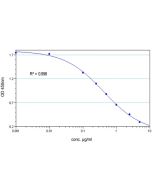Cookie Policy: This site uses cookies to improve your experience. You can find out more about our use of cookies in our Privacy Policy. By continuing to browse this site you agree to our use of cookies.
AdipoGen Life Sciences
Meteorin-like (mouse) (rec.)
As low as
230
CHF
CHF 230.00
In stock
Only %1 left
AG-40B-0149-C01010 µgCHF 230.00
AG-40B-0149-30103 x 10 µgCHF 455.00

| Product Details | |
|---|---|
| Synonyms | Interleukin-41; IL-41; IL41; Metrnl; Subfatin; Cometin |
| Product Type | Protein |
| Properties | |
| Source/Host | HEK 293 cells |
| Sequence |
Mouse meteorin-like [IL-41] (46-311) is fused at the N-terminus to a FLAG®-tag. |
| Crossreactivity | Mouse |
| MW | ~35kDa (SDS-PAGE); ~ 40 kDA (Monomer) (SEC) |
| Purity | ≥95% (SDS-PAGE) |
| Endotoxin Content | <0.1EU/μg purified protein (LAL test). |
| Concentration | 0.1mg/ml after reconstitution. |
| Reconstitution | Reconstitute with 100μl sterile water. |
| Formulation | Lyophilized. Contains PBS. |
| Other Product Data |
Uni-Prot link Q8VE43: Meteorin-like (mouse) |
| Shipping and Handling | |
| Shipping | BLUE ICE |
| Short Term Storage | +4°C |
| Long Term Storage | -20°C |
| Handling Advice |
After reconstitution, prepare aliquots and store at -20°C. Avoid freeze/thaw cycles. Centrifuge lyophilized vial before opening and reconstitution. PBS containing at least 0.1% BSA should be used for further dilutions. |
| Use/Stability |
Stable for at least 6 months after receipt when stored at -20°C. Working aliquots are stable for up to 3 months when stored at -20°C. |
| Documents | |
| MSDS |
 Download PDF Download PDF |
| Product Specification Sheet | |
| Datasheet |
 Download PDF Download PDF |
Description
Meteorin-like (interleukin-41; cometin; subfatin) is a potent new neurotrophic factor promoting neurite outgrowth from dorsal root ganglion cells. Meteorin-like is also a novel adipokine expressed by adipose tissue being downregulated upon caloric restriction. Meteorin-like is secreted by muscles during exercise and converts white adipose cells into brown fat tissue.
Product References
- METRNL attenuates lipid-induced inflammation and insulin resistance via AMPK or PPARδ-dependent pathways in skeletal muscle of mice: T.W. Jung, et al.; Exper. Mol. Med. 50, 122 (2018)







